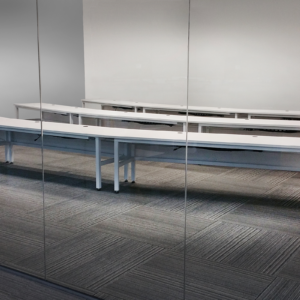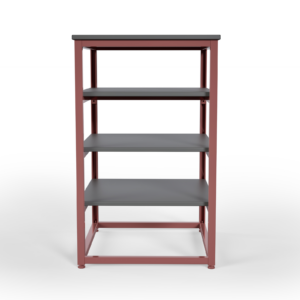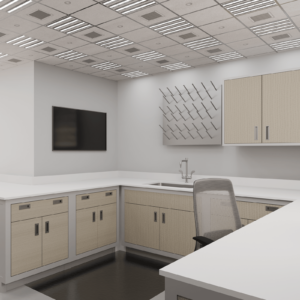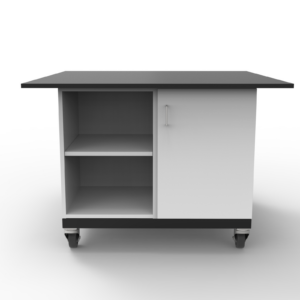As Coronavirus lockdown regulations begin to ease, workers around the country are slowly beginning to return to their places of work – but not without a high degree of apprehension.
Each time commuters get ready to board a train, bus, or airplane, they asked themselves, “Has this seat been sterilized for coronavirus?” These same types of questions weigh on the minds of workers/users returning to office buildings, factories, laboratories, or educational institutions: is the elevator clean? Are the bathrooms safe to use? Is my desk or work surface adequately sterilized?
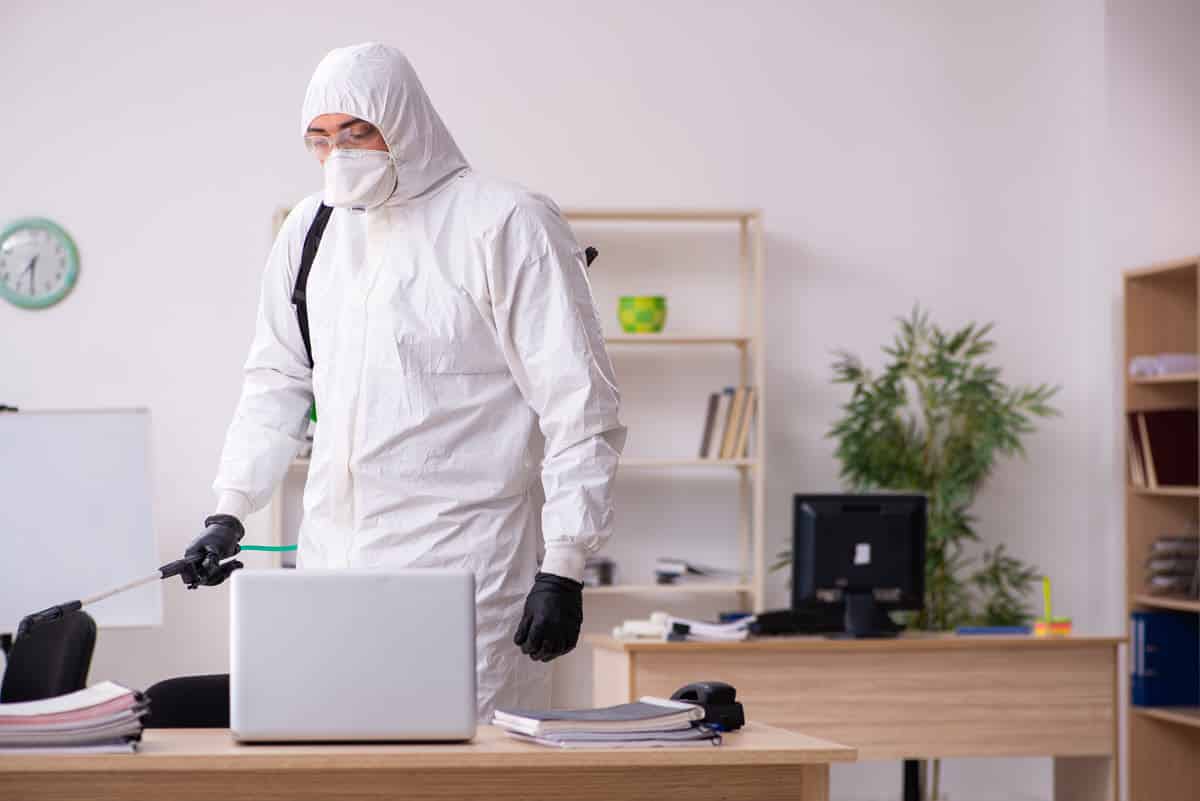
OSHA and the CDC recently issued updated guidelines that outline key steps that facility managers need to follow to help create a safe and healthy work or school environment.
As it turns out, two of the most important safety guidelines are literally in the hands of workers (or students) themselves. They are:
- frequent handwashing throughout the day and avoiding touching your face
- wearing a mask, which protects others from exposure to your germs and viruses
But beyond these two very important recommendations, what can facility managers do to create a cleaner, safer sterilized environment?
We take a look at five different large-scale cleaning methods that are being used around the world to eradicate the Covid-19 virus from built environments and enclosed interior spaces.
01. Chemically-Based Coronavirus Sanitizing Systems
In our earlier articles about the pandemic, we’ve written extensively about laboratory research looking at the telltale “spikes” surrounding the Coronavirus. Understanding how these spikes enter the human body (by infecting ACE-2 Receptors) is crucial for developing successful clinical therapies or even an effective Covid-19 vaccine.
However, for sterilizing a built environment, we need to shift gears and focus on the membrane envelope that surrounds each individual Covid-19 virus particle.
Despite their small size (averaging 0.125 microns in diameter), each of these individual virus particles is encapsulated in a relatively fragile lipid membrane, which you can think of as an infinitesimally small drop of oil (or fat, or grease, if you prefer).
That’s actually good news. It’s relatively easy to break the Covid-19 membrane apart (rendering it effectively “killed”) by vigorous handwashing using ordinary soap and water.
Other detergents and chemicals capable of breaking organisms apart (such as alcohol or bleach-based products) are also effective. Quaternary-based disinfectants (widely used in hospitals) are an excellent choice as well, as they are proven to kill pathogens that are similar to the Covid-19 virus.
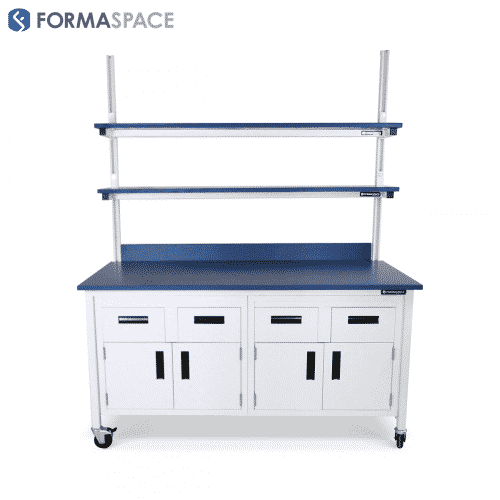
Who uses chemically-based sanitizing systems?
Practically speaking, nearly every facility team around the world is using some form of chemical treatment (including bleach, alcohol, detergent, and quaternary-based disinfectants) to clean potential coronavirus particles from high touch surfaces.
Some businesses, such as hotels sanitizing guest rooms, are spraying disinfectant over wide areas using fogging machines, fumigation sprayers, or electrostatic spraying systems.
However, the EPA cannot recommend these methods as they have not been able to certify that applying the disinfectants in this manner is effective in eradicating the Covid-19 virus.
What chemical products are used?
The EPA maintains a list of currently approved chemicals, with disinfection instructions and contact times. The CDC has also prepared specific instructions for cleaning and disinfecting facilities where exposure to the Covid-19 virus is suspected.
What are the advantages of using chemically-based sanitizing systems?
Chemically-based cleaning methods approved for sterilizing non-porous surfaces (if done in accordance with CDC and EPA recommendations) are a time-tested and well-understood approach used by cleaning staff worldwide.
Most of the cleaning products are relatively safe (although the standard cautions of avoiding mixing chemicals such as bleach with ammonia apply), but these risks are well understood and not specific to the Covid-19 virus.
The list of approved EPA disinfectant products includes hospital-grade quaternary disinfectant cleaners (active ingredient Quaternary ammonium) that have been shown to kill other pathogens, including HIV, Norovirus, and MRSA.
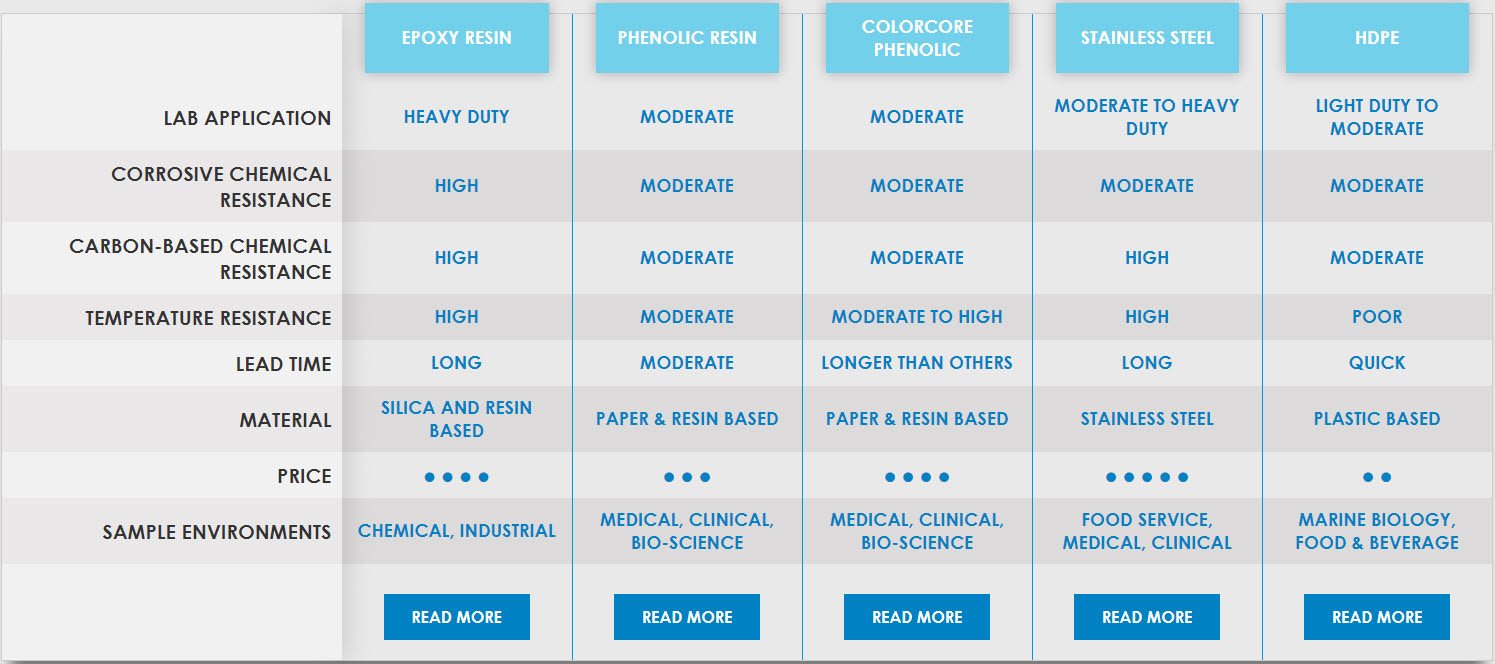
What are the disadvantages of using chemically-based sanitizing systems?
Without an approved method for bulk sterilization (using foggers or sprayers, etc.), the chemically-based sanitation approach remains quite labor-intensive: it takes time for cleaners to apply disinfecting solutions to individual surfaces, wait an appropriate amount of contact time, and then wipe them down afterward.
Many chemically-based systems create fumes and must be used with adequate ventilation. This poses a problem when cleaning the interior of an aircraft, for example, because the long narrow interiors are difficult to ventilate.
While chemical disinfectants do a good job sterilizing hard services (such as stainless steel or laminate worksurfaces, metal door handles, or ceramic toilets), there are fewer products available to clean non-porous surfaces (such as fabric, leather, or upholstery materials).
To find suitable products for cleaning porous materials, search the EPA’s recommended product list for the term “(P)” which indicates porous surfaces; included in this list are quaternary ammonium, hydrogen peroxide, and peroxyacetic acid-based products.
Unfortunately, it appears that treating cloth by laundering is the best cleaning method, but this is not practical in many cases.
Also, some cleaning products can discolor plastics. Test an inconspicuous area first before using it.
02. Ozone-Based Coronavirus Sanitizing Systems
Ozone, which is probably most commonly known as a smog inducing air pollutant, is also a powerful oxidant is used to break apart grease and sterilize clothing in commercial laundries, prevent mold growth on citrus fruit stored in commercial warehouses, and to eliminate the smell of smoke from buildings damaged by fire.
Unfortunately, the concentration of ozone needed to kill coronaviruses inside a building far exceeds the levels of safe human exposure (which is why the EPA specifically recommends against its use for this purpose).
The risk to health is why companies that do use ozone systems (for mold and smoke damage mitigation, for example) have to take extraordinary safety precautions, such as preventing people (or pets) from entering areas undergoing treatment. Ventilating interiors after an application can take hours (or days) before it’s safe for people to be let back in.
Given that coronavirus particles eventually “die” on their own (in a matter of hours and days), in nearly all cases, it makes more economic sense just to close a building and “wait” for the virus to be eliminated on its own, rather than go through the effort of conducting an ozone treatment program.
Who uses ozone-based sanitizing systems?
Laundry facilities at athletic clubs and assisted living facilities are typical customers for commercial laundry systems using ozone, due to its ability to sterilize laundry and eliminate odors.
Disaster mitigation services, such as companies treating buildings for smoke damage, often employ ozone generators to flood interior spaces with high concentrations of ozone to remove the smell of smoke and to kill mold spores.
Similar systems (commonly known as “smoke eaters”), which operate at much lower ozone concentrations, are used by bars and restaurants to reduce odors generated by cigarettes or cigars.

What ozone-generating products are used?
Ozone generating systems use electricity to generate gas. Some designs produce ozone that is dissolved directly into water (for commercial laundries, for example), while others are optimized to release ozone gas directly into the air.
What are the advantages of using ozone-based sanitizing systems?
At high concentrations, ozone gas can sterilize surfaces as well as break down grease, kill mold spores, and eliminate odors.
What are the disadvantages of using ozone-based sanitizing systems?
Breathing ozone at high concentrations can damage the lungs, with potentially lethal results.
Ozone detection meters are a must-have for use with all ozone applications.
While experienced operators are familiar with the “smell” of ozone, most people will first notice a sudden headache followed by possible fainting or a burning sensation in the lungs.
Because ozone damages plastic and rubber items, systems that use ozone regularly, such as commercial laundries, need to be inspected often for leaky gaskets and hoses.
03. UV-Light-Based Coronavirus Sanitizing Systems
Hospitals concerned about MSRA and other difficult to control pathogens have been investing in UV-light based sanitizing systems in recent years to sterilize patient rooms, surgical theaters, even hallways, and waiting rooms.
This technology uses a strong UV light source to expose and break apart the cells of pathogens. It can treat a broad area in minutes, sterilizing all surfaces that are exposed to the light.
Companies around the world are now implementing custom systems to apply this proven technology to different applications, ranging from bus and train interiors to airline interiors. Innovative mechanical devices, such as articulating arms, allow systems to reach underside surfaces that would otherwise remain untreated.
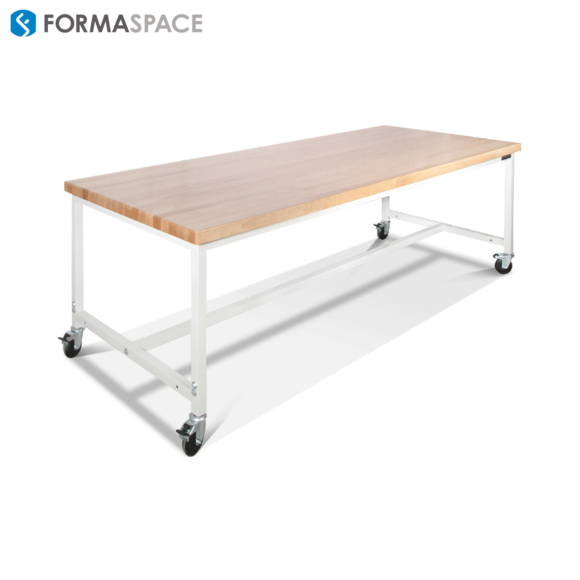
Who uses UV-light-based sanitizing systems?
Hospital systems were the early adopters of UV-light-based sanitation systems.
Transit companies have adapted UV systems to clean bus and train interiors.
Airlines are also investing in UV systems to clean airplane interiors.
What are UV-light-based sanitizing systems used?
High power light sources (often xenon) emit sufficient radiation to sterilize pathogens.
Designers have created convenient form factor packaging, such as robot-like mobile devices that can be rolled from area to area.
Articulated arms can be positioned to shine light in hard to reach places, such as underneath desks or armrests.
What are the advantages of using UV-light-based sanitizing systems?
Sanitation treatments are quick, usually taking just a few minutes per application to clean entire rooms. Operators need to leave the room during the exposure to protect their vision but can return immediately afterward.
Unlike chemically-based or ozone-based systems, there is no requirement to allow the air to ventilate after treatment; once the light is turned off, it is immediately safe for personnel to reenter the space.
What are the disadvantages of using UV-light-based sanitizing systems?
Light must be able to reach a surface for it to be sanitized. Multiple treatments may be needed to access all areas. Systems that add articulated arms with additional light sources help get around this problem; they must be placed by the operator to “shine” the light on all exposed surfaces.
Obtaining a certified system from a known brand may be difficult due to the current high demand. Also, there has been a flood of new vendors entering the market, some with questionable or potentially sub-standard products. For example, light sources that don’t produce sufficient light energy won’t be effective in cleaning viruses.
04. Air Flow and Filter-Based Coronavirus Sanitizing Systems
The recently issued OSHA and the CDC guidelines for reopening facilities, such as offices and schools, offer specific recommendations for managing the air supply inside buildings.
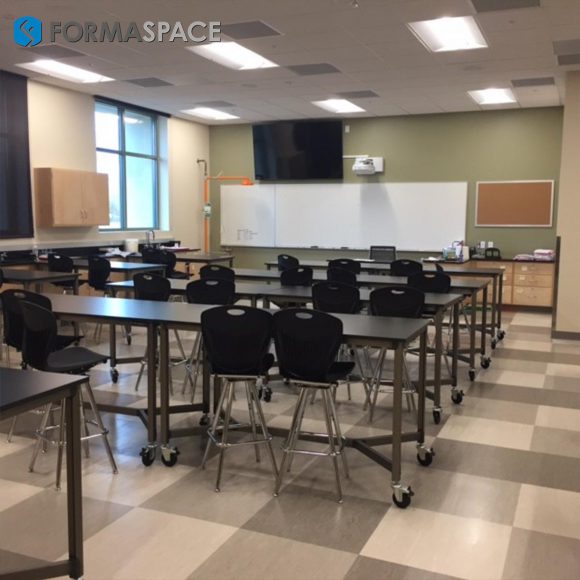
In many ways, the recommendations for controlling Covid-19 virus particles in the air are similar to the standard principles used in cleanroom design.
(Tip: see our article on designing cleanroom applications.)
Here is a quick recap of key cleanroom and fume hood principles:
- Use large volumes of airflow to dissipate particle concentrations.
- Streamline the flow of cleanroom air downward, so particles exit out floor vents.
- Filter any air before recycling.
Extrapolating this to an office situation, we can see the basis for some of the CDC’s new recommendations.
For example, the CDC recommends increasing the interior airflow by turning HVAC fans to a higher setting (to dissipate virus particles, especially in closed areas such as restroom cubicles) and/or opening windows for increased ventilation.
They also recommend disabling air hand dryers in restrooms that could blow virus particles up and around.
Finally, they recommend, where possible, it’s better if the ventilation system directs airflow downward to exhaust vents in the floor (just as in a cleanroom environment) rather than upward to vents in the ceiling; this way the airflow combines with gravity to direct virus particles to the floor – away from people’s mouths and noses.
Who uses airflow and filter-based sanitizing systems?
Nearly all interior environments use some kind of mechanical HVAC system to provide ventilation and conditioned air (windows that open to the outside are uncommon these days).
What airflow and filter-based sanitizing systems are used?
When it comes to airflow patterns in buildings, there is a lot of variation.
HVAC designers working on new construction projects will certainly be taking the new CDC and OSHA recommendation into account, and it’s likely that future systems will incorporate downward airflow patterns. These may be difficult to retrofit in existing buildings, however.
Meanwhile, most HVAC systems use some form of filtration for circulated air, though heavy-duty HEPA filters are probably not the norm.
Given that the average diameter of the Covid-19 virus is around 0.125 microns, it seems like it would be a challenge to capture these small particles using HEPA filtration.
Yet, according to a 2016 NASA study, both HEPA and activated charcoal filters are theoretically capable of filtering out particles as small as the Coronavirus, if a high-quality filter media is used and the overall system is well designed.
What are the advantages of using airflow and filter sanitizing systems?
Updating an airflow and filtration system – particularly in areas with low air circulation, such as restroom cubicle – can reduce the concentration of the virus particles inside the building.
What are the disadvantages of using airflow and filter sanitizing systems?
Updating an HVAC system is costly, especially if ducting needs to be rerouted or new filtration systems need to be installed and maintained.
The use of advanced HEPA filtration systems shouldn’t lull people into a false sense of security. Their use does not diminish the need for proper hygiene, such as frequent handwashing or wearing masks indoors.
05. Heat-Based Coronavirus Sanitizing Systems
There is another specialized method for sterilizing coronavirus particles: high heat exposure.
For example, Ford Motor Company has recently introduced a new feature for its Police Utility vehicles (the special version of the Ford Explorer SUV design for police departments) that allows police department technicians to “bake” the inside of these police vehicles at a temperature of 133F (56C) for at least 15 minutes. (To accommodate this new function, the vehicle enters a special mode where the windows roll up, the air conditioning system switches to the max heat setting, and the engine runs at a higher RPM than normal to bring up the interior temperature up to 133F.)
High heat is used in other ways as well. The worldwide shortage of medical-grade N-95 masks has left researchers looking for a reliable way to extend their use. Research published in the American Chemical Society publication Nano report that these difficult-to-replace masks can be reused up to 50 times if they are disinfected after use at 185F (85C) for 20 minutes.
Who uses heat-based sanitizing systems?
Ford engineers were able to successfully raise the interior temperature of their police vehicles to 133F, thanks to interior plastics designed to withstand even hotter temperatures in full sunlight. However, heat-treating very large interior spaces is generally not practical.
What heat-based sanitizing systems are used?
Aside from cars, heat treatment as a method for sterilization is probably limited to small-scale ovens, such as those used in laboratories or even kitchen ovens.
What are the advantages of using heat-based sanitizing systems?
The method is effective, and, as long as the materials can withstand the extended heat, it’s generally non-destructive. However, some plastics commonly used in 3D printing (such PLA) can start to soften at temperatures as low as 140F (60C).
What are the disadvantages of using heat-based sanitizing systems?
It certainly would be unusual for any normal building’s HVAC system (outside a desert environment) to be capable of raising the interior temperature to 133F (56C) or more. And it’s unlikely any facility manager would try this on purpose, due to the risk of fire, etc.
On the other hand, it’s possible some industrial environments, such as steel-making, could reach temperatures that high. However, the human body can’t withstand temps much higher than 122F (50C) for an extended period of time.
The bottom line is that heat-based sanitizing systems are useful but probably not a mainstream solution for sanitizing large scale interiors.

Formaspace is Your Partner for Better Working Environments
Turn to Formaspace for custom solutions.
If you can imagine it, we can build it – here at our Austin, Texas factory headquarters.
Whether you need new furniture solutions to comply with the new CDC/OSHA guidelines (such a transparent sneeze guards or enhanced desk partitions), or you need assistance designing and manufacturing interior furnishings for your office, factory, laboratory, or school, talk to your Formaspace Design consultant today.
Find out why leading companies, including Capital One, Google, Medtronic, Roche, and SpaceX, turn to Formaspace solutions to make their facilities safer and more efficient.





